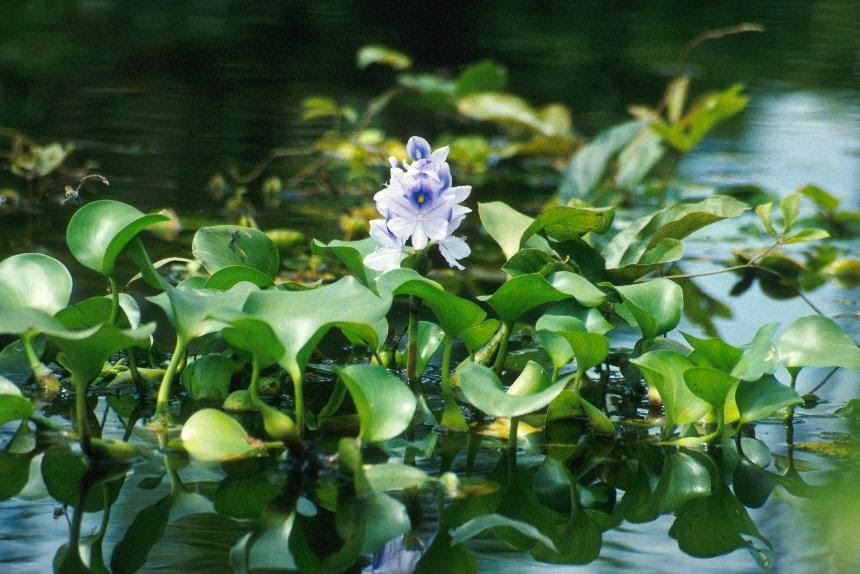
How does water hyacinth grow rapidly in water?
Answer
396.9k+ views
Hint: Water hyacinths are the one of the fastest growing plants, and can double the number of their populations in the duration of two weeks. Water hyacinth doubles its number when it gets favorable conditions to grow in water. Water hyacinth can grow irrespective of the impact they create in a water garden.
Complete answer:
Water hyacinth is common and developed between the slimy filamentous green masses. In spring Water hyacinth grows under water, but when there is enough sunlight and warmth, they produce large amounts of oxygen, which adheres as bubbles between the tangled filaments. The filamentous masses come to the surface and appear as slimy green mats. As we discussed up here about the overall characteristics’ Spirogyra possess, allow us to realize the reproduction. Water hyacinth can reproduce by asexual reproduction by spreading spores. By asexual reproduction, they simply undergo intercalary cellular division to increase the length of the new filaments.
The invasive species is also called a world threat because it outgrows so rapidly and takes up nutrition from the surrounding native species to grow. Either partially or throughout their length. One cell from opposite lined filaments vanishes tubular protuberances referred to as conjugation tubes. Under lower temperature, vegetative reproduction occurs.

Note:
Water hyacinth can be entrenched in water and plants are submerged due to the weight the plant puts in, the native species gets submerged as a result they often die. It results in decaying of those dead plants inside water and leading to killing of fish and other aquatic species. Also known to be an invasive species, water hyacinth can be harmful if not controlled.
Complete answer:
Water hyacinth is common and developed between the slimy filamentous green masses. In spring Water hyacinth grows under water, but when there is enough sunlight and warmth, they produce large amounts of oxygen, which adheres as bubbles between the tangled filaments. The filamentous masses come to the surface and appear as slimy green mats. As we discussed up here about the overall characteristics’ Spirogyra possess, allow us to realize the reproduction. Water hyacinth can reproduce by asexual reproduction by spreading spores. By asexual reproduction, they simply undergo intercalary cellular division to increase the length of the new filaments.
The invasive species is also called a world threat because it outgrows so rapidly and takes up nutrition from the surrounding native species to grow. Either partially or throughout their length. One cell from opposite lined filaments vanishes tubular protuberances referred to as conjugation tubes. Under lower temperature, vegetative reproduction occurs.

Note:
Water hyacinth can be entrenched in water and plants are submerged due to the weight the plant puts in, the native species gets submerged as a result they often die. It results in decaying of those dead plants inside water and leading to killing of fish and other aquatic species. Also known to be an invasive species, water hyacinth can be harmful if not controlled.
Latest Vedantu courses for you
Grade 11 Science PCM | CBSE | SCHOOL | English
CBSE (2025-26)
School Full course for CBSE students
₹41,848 per year
Recently Updated Pages
Master Class 9 General Knowledge: Engaging Questions & Answers for Success

Master Class 9 English: Engaging Questions & Answers for Success

Master Class 9 Science: Engaging Questions & Answers for Success

Master Class 9 Social Science: Engaging Questions & Answers for Success

Master Class 9 Maths: Engaging Questions & Answers for Success

Class 9 Question and Answer - Your Ultimate Solutions Guide

Trending doubts
State and prove Bernoullis theorem class 11 physics CBSE

Who built the Grand Trunk Road AChandragupta Maurya class 11 social science CBSE

1 ton equals to A 100 kg B 1000 kg C 10 kg D 10000 class 11 physics CBSE

State the laws of reflection of light

One Metric ton is equal to kg A 10000 B 1000 C 100 class 11 physics CBSE

Difference Between Prokaryotic Cells and Eukaryotic Cells




